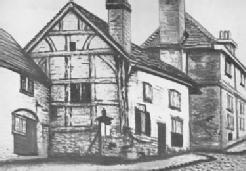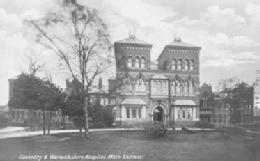The Founding of a Hospital
 Foundation
Foundation
The origins of the Coventry and Warwickshire Hospital reach back to 1838, when there were public calls for such an institution. ‘It is high time that the poor of the City had some other refuge than the workhouse in time of sickness’, wrote the editor of The Coventry Herald. ‘The old corporators annually swallowed in hock, champagne and venison, as much of the public charities as would have supported a hospital’.
The call was heeded, with money soon raised to purchase property in Little Park Street, and for the appointment of three doctors – Bourne, Mellor, and Arrowsmith. When the hospital opened in 1840, it held just twelve beds in one ward.
It was soon apparent, however, that demand far exceeded such meagre provision, and before long further fundraising equipped Coventry with a grand, purpose-built hospital, fit for the demands of an expanding industrial city. The foundation stone for a new hospital on Stoney Stanton Road was laid in a grand Masonic ceremony in 1864, with coins placed in the cavity and the stone sealed with oil and wine as symbols of plenty.
The imposing two-storey building opened to patients in 1867, its Gothic-revival style, twin towers, fine windows, and ornamentation further statements of civic pride in what one commentator described as ‘this excellent institution’.
Hospital Medicine
The new Coventry and Warwickshire Hospital was not just an impressive building; it was also designed in line with the latest medical thinking of the day to offer the necessary air, space and ventilation for health, as well as the latest in medical treatments.
 We are now used to the fact that hospitals are at the very centre of our healthcare system. They are the place where most of us were born and where many of us will probably die – and where, in between these milestones of life, we are likely to spend time if sick or injured.
We are now used to the fact that hospitals are at the very centre of our healthcare system. They are the place where most of us were born and where many of us will probably die – and where, in between these milestones of life, we are likely to spend time if sick or injured.
However, before the mid-nineteenth century, very few people visited hospitals. The rise of the hospital thereafter was due, not just to charity and a desire to care for the poor, but also to a new type of medicine – what some historians have called ‘the rise of hospital medicine’. There was a shift from talking to the patient and examining the exterior of the body to looking and intervening within.
New ‘technologies’ of medicine arose, including greater appreciation of the need for cleanliness and antisepsis, the development of anaesthesia, and the creation of specialised surgical instruments. Hospitals were no longer ‘gateways to death’, but places where scientific knowledge was put to therapeutic use, where the body could be cured of its ailments.
Exhibition tour:
Founding
